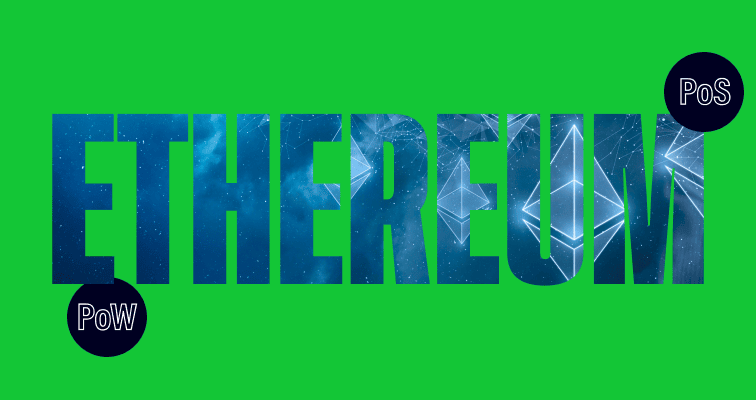Often mentioned alongside Bitcoin, Ethereum is one of the frontrunners in the cryptocurrency and blockchain space. Any investors with an interest in decentralised finance (DeFi) should understand what Ethereum is and how it works. Learn about the history of Ethereum, how it differs from other blockchains and how its cryptocurrency is created.
Ethereum is a secure, peer-to-peer network, with users able to interact directly with one another without the need for third-party intermediaries. It is a layer 1 blockchain that has major implications for the wider decentralised finance (DeFi) industry. Ethereum utilises Solidity, a programming language that allows developers to build and run smart contracts and decentralised applications (dApps) on the blockchain.
Ethereum-based applications are powered by the network’s native cryptocurrency, ether. Ether is currently one of the largest cryptocurrencies by market capitalisation, second only to bitcoin. It is a decentralised and transparent cryptocurrency; ether’s supply is not controlled by a centralised entity and all historic transactions are traceable, accessible and auditable.
History of Ethereum
Ethereum was created, at least in part, as a response to the shortcomings of Bitcoin. The whitepaper was published in 2013 by Vitalik Buterin, one of Ethereum’s co-founders. In 2014, ether was put on sale, with interested parties able to purchase the cryptocurrency with bitcoin.
In July 2015, a scaled-down version of the Ethereum project went live, with developers and miners encouraged to start operating on the network. Any limits were lifted later that year and a default gas fee was introduced.
Since its inception, Ethereum has experienced several forks. These changes provide some benefit to the network, sometimes as a response to malicious attacks. For example, in 2017, the Byzantium Fork reduced block mining rewards and added additional methods of cryptography to allow for additional scalability.
Tip: After a major hack took place in July 2016, the Ethereum network hard forked into two blockchains: Ethereum and Ethereum Classic. Ethereum Classic is a completely separate cryptocurrency and blockchain to its Ethereum counterpart.
Perhaps the biggest change in Ethereum’s short history occurred as a result of the Merge.

The Merge
At its launch, Ethereum utilised a Proof of Work (PoW) consensus mechanism. Proof of Work blockchains use intense computational power to solve complex mathematical problems to determine which node will validate the next block of transactions. PoW blockchains consume — and waste — large amounts of energy.
The Merge saw the transition from Proof of Work to Proof of Stake (PoS), a consensus mechanism that involves ether holders offering their coins as collateral for the chance to validate blocks on the blockchain. Validators are selected randomly, lessening the need for competition and excessive energy usage.
The Merge involved the joining of two different layers: the Mainnet — the original, Proof of Work layer — and the Beacon Chain — the new Proof of Stake consensus layer. This move saw the Ethereum network become more scalable, secure and sustainable.
Shanghai Upgrade
Ethereum’s Shanghai hard fork, also referred to as Shapella, was completed in 2023. This fork helped to improve liquidity and enabled validators to withdraw their staked ether, finalising the transition to a Proof of Stake network. The Shanghai upgrade was released at the same time as the Capella upgrade, hence the moniker “Shapella.”
How is Ethereum different?
As mentioned above, Ethereum was created to improve on some of Bitcoin’s weaker aspects. Although Bitcoin was somewhat revolutionary, it was primarily designed as an alternative to traditional, fiat currencies. The Ethereum whitepaper highlights some potential uses for blockchain technology that Bitcoin fails to utilise. These include the ability to:
- Create custom currencies and financial instruments
- Own underlying, physical assets
- Develop non-fungible assets, such as NFTs
- Implement smart contracts
- Engage with decentralised autonomous organisations (DAO)
Ethereum is an open-source, programmable blockchain and is one of the key players in DeFi. Developers can build applications on Ethereum that can handle and simplify complex financial transactions, among other things. Multiple layer 2 chains have been built on top of Ethereum, alongside various crypto tokens and other cryptoassets.
A blockchain that “[allows] anyone to write smart contracts and decentralized applications where they can create their own arbitrary rules for ownership, transaction formats and state transition functions.”
Ethereum Whitepaper

Ethereum price and forecast for the future
Ether experiences the same volatility as the wider cryptocurrency market, often following bitcoin’s directional price moves. That being said, the price of ETH has seen some significant movement since its launch:
| Year | Start Price | Mid-Year Price | End Price | Percentage Change |
|---|---|---|---|---|
| 2015 | N/A | N/A | $0.93 | N/A |
| 2016 | $0.93 | $12.44 | $7.96 | +755% |
| 2017 | $7.96 | $293 | $756 | +3580% |
| 2018 | $755 | $455 | $133 | -82% |
| 2019 | $133 | $290 | $129 | -3% |
| 2020 | $129 | $226 | $737 | +471% |
| 2021 | $737 | $2274 | $3682 | +399% |
| 2022 | $3683 | $1068 | $1196 | -67% |
Source: Yahoo Finance
Past performance is not an indication of future results.
Much like other asset classes, cryptoassets are subject to bull and bear markets, with the price of ether often fluctuating in line with the wider stock markets, although on a more dramatic level.
It’s impossible to predict the future price of Ethereum’s native cryptocurrency. With Ethereum having positioned itself at the forefront of DeFi, some experts believe that it could one day surpass the market capitalisation of bitcoin. However, there are others who consider Ethereum to be too slow and expensive, predicting that it could be overtaken by newer, faster blockchains in the future. Regardless, it’s important to conduct your own research before buying ether, as with any other financial asset.

Final thoughts
Ethereum has been one of the most important blockchains for demonstrating the immense possibilities of decentralised finance. Although it was Bitcoin that laid the foundations for the move away from fiat currencies, Ethereum has proven that blockchain technology can play a much more significant role than just removing third parties from monetary transactions.
For those looking to invest in ether, it comes with the same risks as any other cryptoasset, with volatile price moves and uncertainty regarding legislation and regulation. Cryptocurrencies can help with portfolio diversification, but are perhaps best suited for investors with a higher-risk profile.
Visit the eToro Academy to learn more about Ethereum and blockchain technology.
FAQ
- How is ether created?
-
Originally, Ethereum’s native cryptocurrency was mined. Following the Merge and the move over to Proof of Stake, ether is minted as a reward for each block validated on the blockchain. Ether holders stake their cryptocurrency to be in with a chance of validating a new block of transactions. Once all of the nodes on the network reach consensus, a set amount of ether is minted and shared among the validators, depending on how much ether they have staked.
- What is ether used for?
-
Ether is primarily used for transaction fees on the Ethereum network. These are referred to as gas fees. If a user wants to make a transaction, they pay ether to have this transaction recognised on the blockchain.
In addition, after the Merge, users need to stake ETH to validate new blocks on the blockchain. Ether can also be used as a form of collateral in DeFi lending markets or as a method of payment.
- What are Ethereum NFTs?
-
Ethereum is one of the most popular blockchains for investing in non-fungible tokens (NFTs). NFTs can be used to represent ownership of an item, secured by the Ethereum blockchain. Ethereum was the first blockchain to really popularise the concept of NFTs, with ERC-721 tokens able to have different properties and values compared to other tokens on the same smart contract. Some of the most popular Ethereum NFTs include CryptoPunks and Bored Ape Yacht Club, linked to ApeCoin.
This information is for educational purposes only and should not be taken as investment advice, personal recommendation, or an offer of, or solicitation to, buy or sell any financial instruments.
This material has been prepared without regard to any particular investment objectives or financial situation and has not been prepared in accordance with the legal and regulatory requirements to promote independent research. Not all of the financial instruments and services referred to are offered by eToro and any references to past performance of a financial instrument, index, or a packaged investment product are not, and should not be taken as, a reliable indicator of future results.
eToro makes no representation and assumes no liability as to the accuracy or completeness of the content of this guide. Make sure you understand the risks involved in trading before committing any capital. Never risk more than you are prepared to lose.


